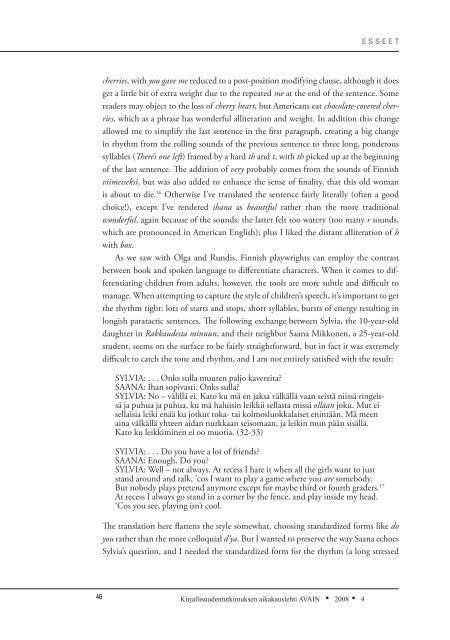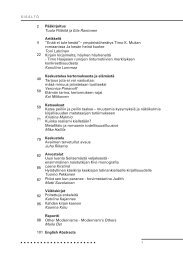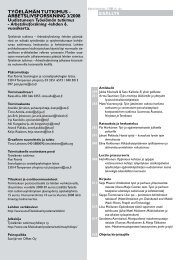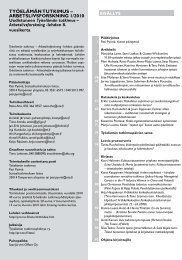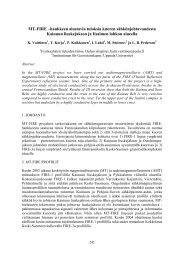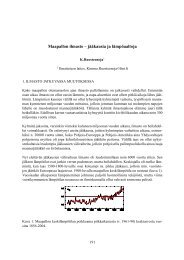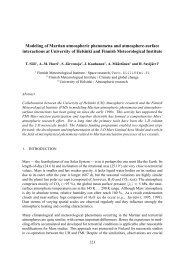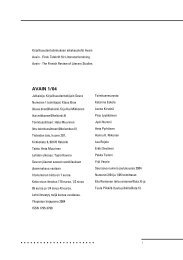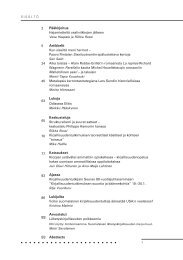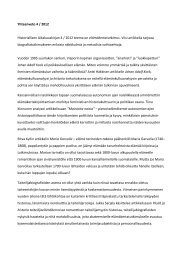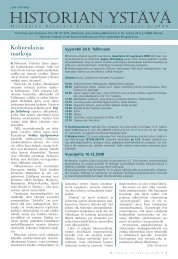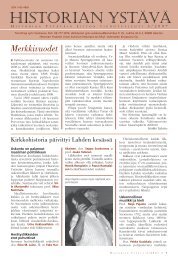Avain 4/2008
Avain 4/2008
Avain 4/2008
Create successful ePaper yourself
Turn your PDF publications into a flip-book with our unique Google optimized e-Paper software.
esseetcherries, with you gave me reduced to a post-position modifying clause, although it doesget a little bit of extra weight due to the repeated me at the end of the sentence. Somereaders may object to the loss of cherry heart, but Americans eat chocolate-covered cherries,which as a phrase has wonderful alliteration and weight. In addition this changeallowed me to simplify the last sentence in the first paragraph, creating a big changein rhythm from the rolling sounds of the previous sentence to three long, ponderoussyllables (There’s one left) framed by a hard th and t, with th picked up at the beginningof the last sentence. The addition of very probably comes from the sounds of Finnishviimeiseksi, but was also added to enhance the sense of finality, that this old womanis about to die. 16 Otherwise I’ve translated the sentence fairly literally (often a goodchoice!), except I’ve rendered ihana as beautiful rather than the more traditionalwonderful, again because of the sounds: the latter felt too watery (too many r sounds,which are pronounced in American English); plus I liked the distant alliteration of bwith box.As we saw with Olga and Rundis, Finnish playwrights can employ the contrastbetween book and spoken language to differentiate characters. When it comes to differentiatingchildren from adults, however, the tools are more subtle and difficult tomanage. When attempting to capture the style of children’s speech, it’s important to getthe rhythm right: lots of starts and stops, short syllables, bursts of energy resulting inlongish paratactic sentences. The following exchange between Sylvia, the 10-year-olddaughter in Rakkaudesta minuun, and their neighbor Saana Mikkonen, a 25-year-oldstudent, seems on the surface to be fairly straightforward, but in fact it was extremelydifficult to catch the tone and rhythm, and I am not entirely satisfied with the result:SYLVIA: . . . Onks sulla muuten paljo kavereita?SAANA: Ihan sopivasti. Onks sulla?SYLVIA: No – välillä ei. Kato ku mä en jaksa välkällä vaan seistä niissä ringeissäja puhua ja puhua, ku mä haluisin leikkii sellasta missä ollaan joku. Mut eisellaisia leiki enää ku jotkut toka- tai kolmosluokkalaiset enintään. Mä meenaina välkällä yhteen aidan nurkkaan seisomaan, ja leikin mun pään sisällä.Kato ku leikkiminen ei oo muotia. (32-33)SYLVIA: . . . Do you have a lot of friends?SAANA: Enough. Do you?SYLVIA: Well – not always. At recess I hate it when all the girls want to juststand around and talk, ’cos I want to play a game where you are somebody.But nobody plays pretend anymore except for maybe third or fourth graders. 17At recess I always go stand in a corner by the fence, and play inside my head.‘Cos you see, playing isn’t cool.The translation here flattens the style somewhat, choosing standardized forms like doyou rather than the more colloquial d’ya. But I wanted to preserve the way Saana echoesSylvia’s question, and I needed the standardized form for the rhythm (a long stressed46Kirjallisuudentutkimuksen aikakauslehti AVAIN • <strong>2008</strong> • 4


